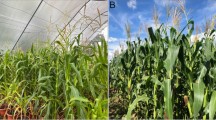Abstract
Sugarcane response data from field experiments conducted between May 1979 and August 1981 on a sandy clay loam soil (Udic Haplustalf) of Coimbatore district, Tamil Nadu State, India were used in the present investigation. Soil (α) and fertilizer (β) nutrient efficiencies for the amount of fertilizer required for specified cane yield targets were computed from this data by three procedures, viz., conventional deduction procedure, Tamil Nadu Agricultural University Model I [TNAU Model I] and Model II [TNAU Model II].
In the case of nitrogen, both TNAU Model I and TNAU Model II gave more realistic estimates ofα andβ than those determined by the conventional deduction procedure. The differences in the predicted amounts of fertilizer nitrogen required between these two models were well within the permissible limits of variation indicating that both these approaches can be followed for the amount of nitrogen required for specified yield targets.
The Olsen's procedure for available phosphorus estimation was inadequate to explain the relationship between soil available phosphorus and sugarcane response as indicated by results obtained using the TNAU Model II. The incorporation of the termγ in this model caters for the actual situation in the field in respect of the relationship between soil and fertilizer phosphorus availabilities and phosphorus uptake by sugarcane proving usefulness of this model for assessing the amount of phosphorus required for specified cane yield targets.
The results indicated that a considerable amount of potassium from the soil reserve was released into the soil available pool due to a priming effect. This fraction was preferentially absorbed by sugarcane compared to the fractions extracted by 0.1 N HNO3 as indicated by results obtained using the TNAU Model II. In this case too, the actual situation regarding the relationship between soil and fertilizer potassium availabilities and potassium uptake by sugarcane is catered for by this model proving its superiority over the other two procedures for assessing the amount of potassium required for specified yield targets.
Similar content being viewed by others
References
AOAC (1960) Official and tentative methods of analysis association of official agricultural chemists. Washington, DC
Bray RH (1954) A nutrient mobility concept of soil and plant relationships. Soil Sci 78: 9–22
Jackson ML (1973) Soil chemical analysis. Prentice Hall of India Private Limited, New Delhi pp 151–153
Maruthisankar GR, Velayutham M, Reddy KCK and Singh KD (1983) A new method for better estimation of soil and fertilizer efficiencies. Indian J Agric Sci 53:314–319
Murugappan V, Kothandaraman GV, Palaniappan SP and Manickam TS (1988) Fertilizer doses for specified yield targets. I. Theoretical derivation of mathematical models for the computation of soil and fertilizer nutrient efficiencies. Fert Res ibid
Olsen SR, Cole CV, Watanabe FS and Dean LA (1954) Estimation of available phosphorus in soils by extraction with sodium bicarbonate USDA Circ 939, US Govt Printing Office, Washington, DC
Perumal K (1981) Sugarcane nutrition norms for more sugar. Kothari sugars and chemicals, Madras, India
Piper CS (1966) Soil and plant analysis. Hans publishers, Bombay, India
Ramamoorthy B and Velayutham M (1971) Soil test crop response correlation work in India. Soil Resources report No. 41. Soil Survey and Soil Fertility Research in Asia and Far Asia 14:19–105
Ramamoorthy B, Narasimhan RL and Dinesh RS (1967) Fertilizer application for specified yield targets of Sonora 64 (wheat). Indian Fmg 17:43–45
Rani Perumal and Velayutham M (1979) Relative contributions of forms of soil nitrogen, phosphorus and potassium to rice and soil test methods. Proc of the Seminar on response of crops to application of P and K and soil fertility evaluation. Tamil Nadu Agricultural University, Coimbatore, India, 407–416
Subbiah BV and Asija GL (1956) A rapid procedure for the estimation of available nitrogen in soils. Curr Sci 25:259–260
Sobulo RA (1973) Evaluation of analytical methods for determining K status of Nigerian soils. Proc 10th Coll. Int. Potash Inst. Abidjan Ivory Coast, 119–129
Author information
Authors and Affiliations
Rights and permissions
About this article
Cite this article
Murugappan, V., Kothandaraman, G.V., Palaniappan, S.P. et al. Fertilizer requirements for specified yield targets. II. Field verification of mathematical models for the estimation of soil and fertilizer nutrient efficiencies. Fertilizer Research 18, 127–140 (1988). https://doi.org/10.1007/BF01049509
Received:
Accepted:
Issue Date:
DOI: https://doi.org/10.1007/BF01049509




